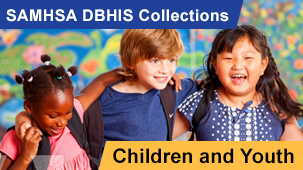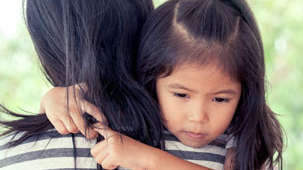
Children and Mental Health After Disasters |
The American Academy of Pediatrics (AAP) notes that “Children have unique physical, mental, behavioral, developmental, communication, therapeutic, and social needs that must be addressed in all aspects of disaster preparedness, response, and recovery."1 Understanding how children may react to disasters can help parents and caregivers support their children in coping and seek additional help for children if needed. The resources below include information for parents and caregivers about how children may experience and respond to disaster, signs of the need for professional mental health assistance, and how they can help their children in the most effective way. |
Children and Youth This SAMHSA Disaster Behavioral Health Information Series installment highlights resources for and about children and youth during and after a disaster. The resources listed can help parents, other caregivers, and educators to support disaster preparedness for children; children and youth to understand and cope with their disaster reactions; and school personnel to ensure disaster preparedness for their institutions. This SAMHSA Disaster Behavioral Health Information Series installment highlights resources for and about children and youth during and after a disaster. The resources listed can help parents, other caregivers, and educators to support disaster preparedness for children; children and youth to understand and cope with their disaster reactions; and school personnel to ensure disaster preparedness for their institutions. |
The Emotional Impact of Disaster on Children and Families In this training module, the AAP discusses how a disaster can lead to emotional difficulties in children and factors that can increase the likelihood of issues, such as age and previous mental health issues. The second section of the module lists the stages of emotional response after a disaster and the most common symptoms and conditions in children exposed to disasters. The module also reviews various interventions to support children after disaster. In this training module, the AAP discusses how a disaster can lead to emotional difficulties in children and factors that can increase the likelihood of issues, such as age and previous mental health issues. The second section of the module lists the stages of emotional response after a disaster and the most common symptoms and conditions in children exposed to disasters. The module also reviews various interventions to support children after disaster. |
Your Child Is at Risk for Mental Health Issues After a Disaster On this web page, the Centers for Disease Control and Prevention describes how disasters may affect children, including mental health issues and conditions, and highlights ways for parents and caregivers to help children cope. The page also lists signs of the need for help from a mental health professional and other resources related to helping children after a disaster. On this web page, the Centers for Disease Control and Prevention describes how disasters may affect children, including mental health issues and conditions, and highlights ways for parents and caregivers to help children cope. The page also lists signs of the need for help from a mental health professional and other resources related to helping children after a disaster. |
Helping Children and Adolescents Cope With Disasters and Other Traumatic Events In this publication, the National Institute of Mental Health defines and describes trauma, including trauma linked to disasters, and identifies ways in which children and adolescents may react to trauma. It also offers ways that parents and caregivers, rescue workers, and community members can help children and adolescents in recovering from trauma. This page is available as a PDF download and in Spanish. In this publication, the National Institute of Mental Health defines and describes trauma, including trauma linked to disasters, and identifies ways in which children and adolescents may react to trauma. It also offers ways that parents and caregivers, rescue workers, and community members can help children and adolescents in recovering from trauma. This page is available as a PDF download and in Spanish. |
Help Improve SAMHSA’s Disaster Services and Products As a subscriber to this newsletter, you are invited to participate in a short, web-based survey to provide the SAMHSA Disaster Technical Assistance Center (DTAC) with feedback about your experiences with our products and services. The survey should take no more than 15 minutes. Complete the survey by clicking on this link, or copy and paste the URL https://iqsolutions.qualtrics. As a subscriber to this newsletter, you are invited to participate in a short, web-based survey to provide the SAMHSA Disaster Technical Assistance Center (DTAC) with feedback about your experiences with our products and services. The survey should take no more than 15 minutes. Complete the survey by clicking on this link, or copy and paste the URL https://iqsolutions.qualtrics. |
Subscribe to The DialogueThe Dialogue is a quarterly e-newsletter that provides practical and down-to-earth information for disaster behavioral health coordinators, local service providers, federal agencies, and nongovernmental organizations. You can subscribe to the newsletter or contact the SAMHSA Disaster Technical Assistance Center (DTAC) by email at dtac@samhsa.hhs.gov to contribute an article to an upcoming issue. |
Questions About the SAMHSA DTAC Bulletin?The SAMHSA DTAC Bulletin is a monthly newsletter used to share updates in the field, post upcoming activities, and highlight new resources. For more information, please contact: The views, opinions, and content expressed in this publication do not necessarily reflect the views, opinions, or policies of the Center for Mental Health Services (CMHS), the Substance Abuse and Mental Health Services Administration (SAMHSA), or the U.S. Department of Health and Human Services (HHS). 1AAP. (n.d.). Children & disasters: Disaster preparedness to meet children’s needs. Retrieved from https://www.aap.org/en-us/ |






















.png)











No hay comentarios:
Publicar un comentario